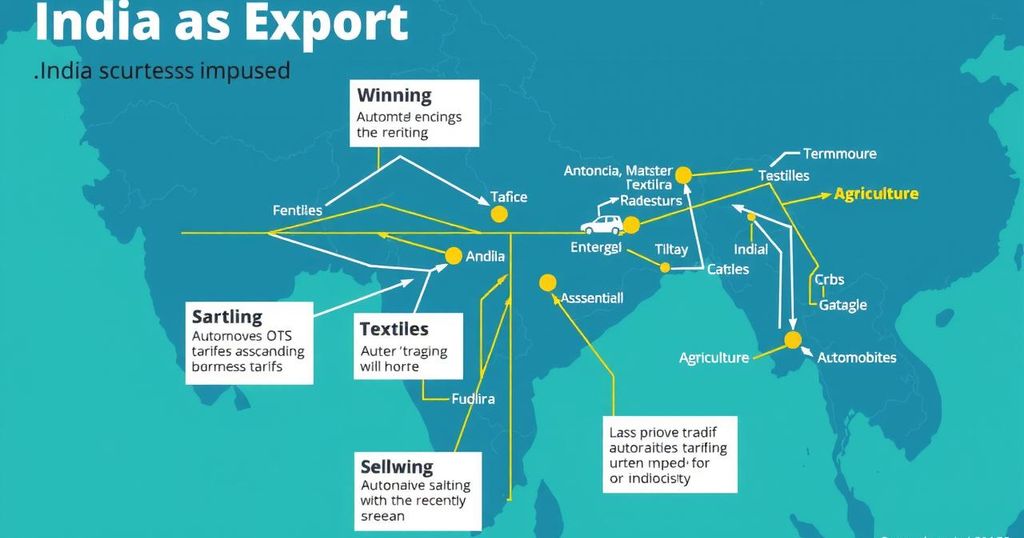Cars
AFRICA, ASIA, AUTOMOTIVE INDUSTRY, BANGLADESH, CAMBODIA, CANADA, CHINA, DONALD TRUMP, EXPORTS, FOREIGN INVESTMENT, HONDA, INDIA, INDONESIA, INTERNATIONAL TRADE, JAGUAR LAND ROVER, MEXICO, NISSAN, NORTH AMERICA, PHILIPPINES, SAUDI ARABIA, SOUTH AFRICA, SRI LANKA, SUPPLY CHAIN, TATA MOTORS, THAILAND, TRADE, UNITED STATES, US, VIETNAM
Amira Khan
0 Comments
Impact of Trump’s Tariffs on Indian Exports: Challenges and Opportunities
India, the 12th-largest exporter in 2023 with $441 billion in exports, faces a 27% tariff on exports to the US. Although challenges exist, India benefits from lower tariffs in comparison to competitors like China and Vietnam. Certain sectors such as textiles and gems and jewellery may experience positive impacts, despite the overall tariff burden. The potential for bilateral trade agreements may further mitigate issues arising from these tariffs.
As of 2023, India ranks as the 12th-largest exporter globally, with total exports amounting to $441 billion. Recent developments have introduced a 27 percent flat tariff on all Indian exports to the United States, creating challenges for local exporters. Despite this, India appears to have a more favorable position compared to major competitors such as China, Vietnam, Bangladesh, and Indonesia, which face higher tariffs.
China is subjected to a 34 percent tariff, while Vietnam faces a steep 46 percent. Other countries such as Bangladesh and Thailand endure tariffs of 37 percent. Notably, Cambodia has the highest tariff at 49 percent, followed by Sri Lanka with a 44 percent tariff. These increased tariffs on competing nations may provide India a strategic advantage in certain export categories.
Indian automobile exports to the US, although affected by a 25 percent tariff on imported cars, constitute a minor percentage of total exports with only 0.13 percent from passenger vehicles and 3 percent from commercial vehicles. Tata Motors could indirectly bear consequences through its Jaguar Land Rover division, as a significant portion of its revenue is derived from the US market.
In the auto components market, India’s exports to the US represent one-third of its total auto industry exports of $21.2 billion. However, this accounts for just 2 percent of US auto component imports, which positions India behind Mexico, Canada, and China in this sector. Interestingly, less than 0.5 percent of India’s overall car exports were directed to the US in 2023, with Saudi Arabia, South Africa, and Mexico being the main destinations.
In the textile industry, India is poised to benefit from the new tariffs, as competitors like Vietnam, Bangladesh, and China are subjected to much higher duties. While India holds 8 percent of US textile imports, competitors such as China and Vietnam face import duties of 30 and 13 percent, respectively. With textiles contributing only 2 percent to India’s GDP compared to 11 percent for Bangladesh, India’s economy appears relatively insulated from shocks in this sector.
In the gems and jewellery market, India is a vital source, supplying 12.99 percent or $11.58 billion of total US imports. Competing nations contribute far less, thus reinforcing India’s strong standing in this segment. Consequently, Indian exporters may experience the most detrimental impacts from the tariffs compared to their competitors.
India’s agricultural exports, particularly basmati and non-basmati rice, buffalo meat, and wheat, are also affected by the 27 percent tariff. Nonetheless, India retains a competitive edge in processed food items compared to China, Vietnam, Thailand, and Bangladesh. However, when compared to Mexico, which enjoys a tax advantage under the US-Mexico-Canada Agreement, India’s competitiveness in fresh produce and packaged foods may diminish due to higher shipping costs and tariffs.
The electronics sector, valued at $14 billion in exports to the US, faces increased costs due to the new tariffs. Nevertheless, India surpasses Vietnam and China in terms of tariff rate. Mexico maintains a competitive edge through tariff-free access for compliant electronics under the USMCA. Current negotiations for a bilateral trade agreement between India and the US may present potential relief from these tariffs. Overall, despite the challenges posed by tariffs, India is relatively better positioned than its key competitors in several sectors, enhancing the potential for competitive exports.
In conclusion, India’s exports face significant challenges due to the newly implemented 27 percent tariff by the United States. While sectors such as textiles and gems and jewellery may see relative advantages, Indian exporters must navigate the complexities of the evolving tariff landscape. The ongoing trade negotiations between India and the US offer a glimmer of hope for easing these tariffs and bolstering India’s position in various export markets. Thus, while hurdles exist, India’s strategic positioning compared to competitors remains a point of optimism for exporters.
Original Source: www.business-standard.com




Post Comment